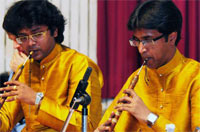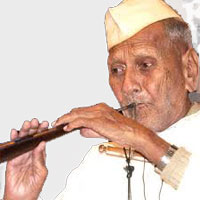SHEHNAI
History
Shehnai (or surnai) the wind instrument is believed to have been introduced in India by the Muslims. One of the most prominent occasions it is used is the ensemble called the naubat (or nahabet), which was played at the courts of the Mughal emperors. Naubat consists of a varying number of specific instruments - kettledrums of various sizes, other types of drums, trumpets, horns, cymbals, and shehnais with their accompanying drones.Later until the beginning of the 20th century this wind instrument was granted the status of a classical instrument. Further small and subtle modifications were made in the instrument to improve its timbre and range, as also the shehnai player`s conscious assimilation of the subtleties of classical raaga-based music and informed cultivation of tonal beauty, greatly facilitated its acceptance as a concert instrument.
 The major contributions made by players such as Chhote Khan, Gaurishankar and Nandlal, Chhote Khan`s disciple, belonging to Benaras, elevated the Shehnai to the level of a concert instrument. For years it is Benaras that has come to be associated with the instrument and still continues to produce some of the finest players on the country. More than anyone else it is Ustad Bismillah Khan who was solely responsible for popularising the Shehnai as a concert instrument both nationally and internationally. Though the instrument possesses certain inborn limitations, such as its inability to execute bass notes, its timbre and tone are extremely gentle and tuneful on the ear.
The major contributions made by players such as Chhote Khan, Gaurishankar and Nandlal, Chhote Khan`s disciple, belonging to Benaras, elevated the Shehnai to the level of a concert instrument. For years it is Benaras that has come to be associated with the instrument and still continues to produce some of the finest players on the country. More than anyone else it is Ustad Bismillah Khan who was solely responsible for popularising the Shehnai as a concert instrument both nationally and internationally. Though the instrument possesses certain inborn limitations, such as its inability to execute bass notes, its timbre and tone are extremely gentle and tuneful on the ear. Introduction
Shehnai is the predominant double-reed wind instrument used in North Indian music. Smaller than the Nadasvaram, the size of Shehnai ranges from one to one and a half feet. It is made completely of wood except for the metal bell at its enlarged lower end, bore is conical and total of seven playing holes and one or two more for adjusting the pitch. This double reed is attached to a narrow stem that rises out of the top of the instrument.How to play a Shehnai
As the flute, all musical notes are produced with the controlled flow of breath through the reed into the tube area. Agile finger-work is required to execute the movements, graces and ornaments of classical music for shehnai. However, these days it is not uncommon for the shehnai player to use the tabla alongside the duggad. Benaras is to this day is the leading producer of some of the finest shehnais in the country.Popular Musicians

BHARAT RATNA Ustad Bismillah Khan is the outstanding and popular contemporary shahnai player.
Importance
In Indian weddings always Shehnai is either played as a back ground score or professionals are hired to play Live. The sound of a Shehnai has been intrinsically associated with Indian wedding music since time immemorial in the country. However inspite of all the changes taking place, Shehnai still retains its charm as a wedding music in the nation.India shehnai is a popular musical instrument and falls in the category of aero phonic instruments. It has been believed to bring good luck that is why in North Indian marriages and processions Shenani is predominantly played. It is a tube-like instrument that gradually widens towards its lower end and for rhythm, resonance. By controlling the breath, various tunes are played on shehnai. According to the scholars of the Indian music, the present day shehnai was developed by improving upon the pungi.
Breath control is the key importance for playing shehnai and all the tunes of full tone, half-tone and sharp notes can be played on shenai through breath control. The notes are continuous and are generally used in classical and light classical music. Shehnai usually closely resembles the Nadaswaram, a prominent musical instrument of South India.
Where to learn to play a Shehnai
TARANG School for Classical Indian Dance and MusicManager: Marie-Luise Siebenkaes
Johannisstrasse 14D-90763 Fuerth
Germany Telephone: +49-(0)911-6708040
Fax: +49 (0)1212-512616701 USt-IdNr.: DE228189973
Where to buy a Shehnai
Contact: Mr Ashish ShrivastavaSathyadeep Musical Palace
Beside Vysya Bank
Post- Puttaparthy
Dist-- Anantapur
Andhra Pradesh Pin- 515134
INDIA
[email protected]
[email protected]


